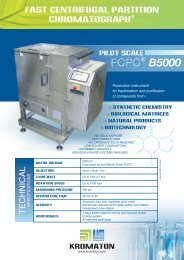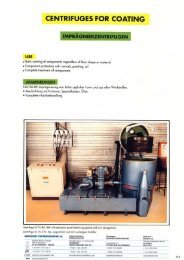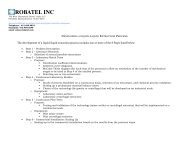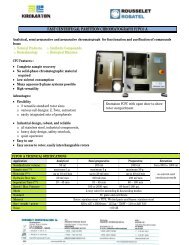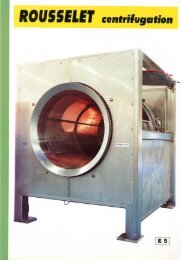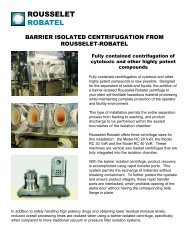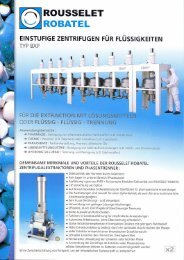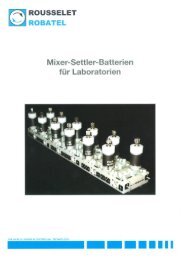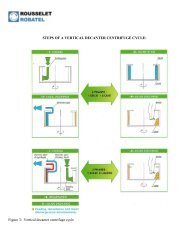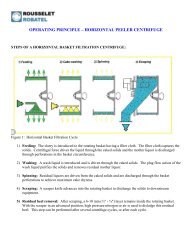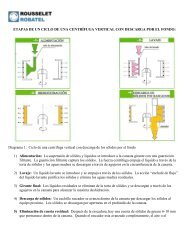Multistage centrifugal extractor operating principle - Rousselet Robatel
Multistage centrifugal extractor operating principle - Rousselet Robatel
Multistage centrifugal extractor operating principle - Rousselet Robatel
Create successful ePaper yourself
Turn your PDF publications into a flip-book with our unique Google optimized e-Paper software.
703 West Housatonic Street – Ste L15<br />
Pittsfield, Massachusetts 01201-6616<br />
manufacturing centrifuges and <strong>centrifugal</strong> extraction equipment<br />
Flow Diagram D: Illustrates contact between one heavy phase and two miscible light phases; for example<br />
three extraction stages plus one stage of heavy phase washing with a diluent (or other combinations).<br />
PILOT SCALE TESTING<br />
For any <strong>centrifugal</strong> <strong>extractor</strong>, the maximum throughputs and extraction efficiencies can only be<br />
determined by testing the technology on a laboratory and pilot scale. The performance parameters of a<br />
multistage <strong>centrifugal</strong> <strong>extractor</strong> will vary depending on the solvents used, viscosity, temperature, density<br />
ratio, surface tension, and phase flow rate ratio.<br />
Specifically, for a <strong>centrifugal</strong> <strong>extractor</strong>, G-force and the mixing energy are important factors to consider<br />
during testing. As shown in the table below, increased rotational speed provides a higher driving force for<br />
separation. However, as rotational speed increases, this will also increase the mixing energy imparted to<br />
the liquid / liquid system.<br />
Therefore, the maximum rotational speed may not yield the best results. The vigorous mixing at the<br />
higher speed may create a dispersion that is more difficult to separate. Typically, there is a “bandwidth”<br />
of rotational speeds that balances the right amount of mixing with adequate G-force for effective<br />
separation. By testing at several different rotational speeds on a pilot scale, this bandwidth can be quickly<br />
evaluated.<br />
G-FORCE AT BOWL WALL<br />
2000<br />
1800<br />
1600<br />
1400<br />
1200<br />
1000<br />
800<br />
600<br />
400<br />
200<br />
G-FORCE AT BOWL WALL VS. ROTATIONAL SPEED FOR ROUSSELET<br />
ROBATEL MULTISTAGE CENTRIFUGAL EXTRACTORS<br />
LX 570<br />
LX 520<br />
0<br />
0 200 400 600 800 1000 1200 1400 1600 1800 2000 2200 2400 2600 2800 3000 3200 3400 3600 3800<br />
ROTATIONAL SPEED (RPM)<br />
LX 360<br />
LX 320<br />
Figure 5: Rotational speed vs. G-force for <strong>Rousselet</strong> <strong>Robatel</strong> multistage <strong>centrifugal</strong> <strong>extractor</strong>s<br />
LX 200<br />
LX 120



